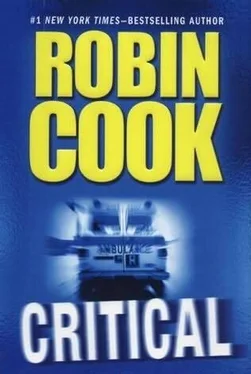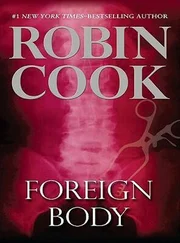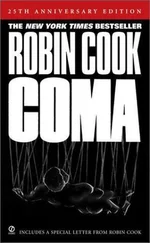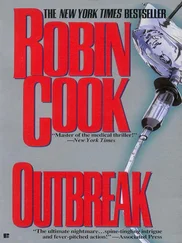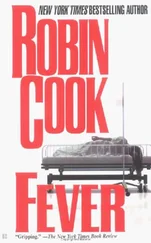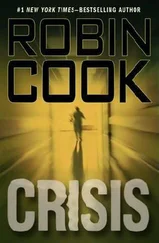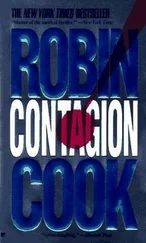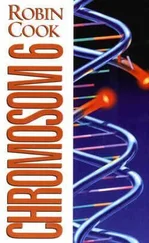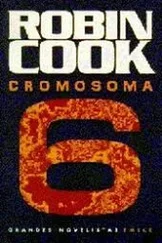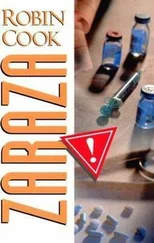Returning to the matrix and slowing down, she let her eyes pause at each entry in each of the categories, such as age, duration of the procedure, type of anesthesia, et cetera, but still nothing significant caught her attention. Coming to the end of the matrix, Laurie switched her gaze to the wall clock. It was seven-thirty exactly, and Jack's surgery was starting. Laurie could visualize the scalpel cut through the skin, and she winced at the thought. Looking back at her matrix, she felt sorry she had finished filling it in. The process itself had been effective in keeping her mind from thinking about what she preferred not to think about.
Suddenly, Laurie thought of something else she could do to avoid obsessing over what was happening to Jack. She thought of Dr. Collin Wylie in New Zealand and the possibility that he'd gotten the photomicrograph, and the possibility he'd had an opportunity to look at it, and if he had, whether he'd been able to recognize it and respond. There were a lot of ifs, but, undeterred, Laurie went to her e-mail. The main reason she'd not thought about doing so earlier was because the outgoing e-mail had been sent during the night, and she'd forgotten to factor in that New Zealand was on the opposite side of the world, meaning in Auckland it had been morning.
The moment after she'd clicked the appropriate icon and her e-mail opened, she saw it: C_Wylie@NYU.EDU. Eagerly, Laurie opened it.
Dr. Montgomery: Greetings from Down Under I received the photomicrographs from Peter, and I have already duly chastised him for not recognizing an acanthamoeba polyphaga cyst, although I gave him some slack because of the location. I have never seen one in the lung. If you want to see it better, use an iodine stain. As for the evanescent nodularity Peter mentioned, I can only assume that it represents encasement of more of the same MRSA as is seen free in the microscopic field. It has been recently demonstrated in Bath, England, that MRSA can invade and multiply within acanthamoeba, similar to legionella, the cause of Legionnaire's disease. Since acanthamoeba normally eat bacteria, it is interesting to wonder how the MRSA and legionella have developed antiamoebic resistance, if you will, and how molecularly similar the process is to their antibiotic resistance. I will be back in the city on Monday. If I can be of any additional assistance please do not hesitate to contact me.
ALL THE BEST, COLLIN WYLIE
As astonished as she was about what she was reading, Laurie had read the e-mail without blinking, and she had to make up for it by squeezing her eyes shut and then blinking several times in a row. She knew next to nothing about amoebas in general or acanthamoeba in particular. Leaning over, she pulled her Harrison's Principles of Internal Medicine from the shelf and rapidly looked up acanthamoeba. The reference was short, and merely part of a general article about infection with free-living amoeba. It talked about acanthamoeba causing an encephalitis, but nothing about pneumonia. It also mentioned that the CDC had a fluorescein-labeled antiserum available for definitive diagnosis, which Laurie thought might be helpful to confirm Dr. Wylie's impression.
Laurie replaced the textbook and scanned her shelf for a possible second source. Not seeing one, she repositioned herself at her monitor screen and Googled acanthamoeba. A large number of hits appeared in seconds. She chose a general one.
With a growing sense of urgency, Laurie scanned the first part of the article, which described the protozoa as one of the most common in soil and fresh water. It described some of its characteristics, including the fact that it was a free-living bacterivore but could on rare occasions cause infections in humans. The next paragraph elaborated this issue at length, and Laurie quickly skimmed it.
It was at that point that Laurie's eyes encountered the caption of the next paragraph: Acanthamoeba and MRSA! With a surge of adrenaline coursing through her body, Laurie read an elaboration of what Dr. Wylie had mentioned, namely, that MRSA had recently been shown to be able to infect acanthamoeba. But in addition to what he'd cited, the article stated that the MRSA that emerged from the amoeba was frequently more virulent. And then, experiencing a reaction akin to a bolt of electricity passing through her, Laurie read that acanthamoeba cysts infected with MRSA can act as a mode of airborne dispersal for MRSA!
Laurie rocked back in her chair and stared blankly at her monitor screen. She was stunned. She'd been confident that MRSA could not be aerosolized, but now she was aware it could be, so all potential scenarios concerning how the MRSA was spread were back on the table, particularly the idea that the Angels hospitals HVAC systems could be involved.
With some difficulty, Laurie tried to calm herself. She had to think, and with her pulse racing and ideas flying around inside her brain, it was difficult. She took a few deep breaths, and after doing so, she remembered another reason she'd dismissed airborne spread as a serious possibility: The patients never breathed room air after being inducted. It was always bottled air or cleaned and piped-in air.
Laurie thought about this stumbling point. It seemed so definitive, or was it? With a mounting fear that her concerns were legitimate, she snapped her phone off the hook. Even though a quarter to eight might have been the worst time to call an anesthesiologist, as all the seven-thirty cases were being inducted, Laurie called over to the Manhattan General Hospital. She'd worked on a case with the MGH's chief of anesthesia, Dr. Ronald Havermeyer, and he'd been extraordinarily helpful. Laurie was sure he, of all people, could reassure her about patients never breathing OR air and would be happy to do so. Additionally, his being chief meant that he was in a supervisory role and might be available.
Nervously tapping her fingers on her desktop, Laurie willed the connection to go through as quickly as possible.
"Dr. Havermeyer," a voice finally said.
Laurie quickly explained who she was and without explaining why, asked her question.
"It's true," Dr. Havermeyer said. "The patient never breathes room air after induction until they get to the PACU, and even there they are often maintained on piped-in sources."
"Thank you," Laurie said.
"Not at all. I'm glad I could help."
Laurie was about to hang up when Dr. Havermeyer asked why she wanted to know.
Quickly, Laurie sketched out her concern – namely, whether bacteria in the HVAC system could be responsible for postoperative nosocomial pneumonia.
"Are you talking about an extended period of breathing ambient air, or just three or four breaths over fifteen or twenty seconds?"
Laurie felt her throat go dry as she intuitively sensed she was about to hear something she did not want to hear.
"Because if it's the latter, there usually is a time," Dr. Havermeyer said. "When the surgeon gives the word and it's time to wake the patient up, or at least terminate the anesthesia, the anesthetist frequently flushes the system with pure oxygen in order to get a faster turnover time for the OR. During the flush, the patient might take two, three, or even four breaths. So it's possible." Laurie thanked the doctor and hung up.
Suddenly, her fears coalesced. MRSA could spread airborne if encysted with acanthamoeba, and patients having general anesthesia did, even if for only a few seconds, breathe ambient OR air. Laurie snapped up the paper on which she'd written the days of the week her cases had occurred. Her memory told her that orthopedic cases were on Monday and Thursday, and it was unfortunately true. It was also unfortunately true that it was Thursday that very day, the day Jack had to have his surgery.
With growing desperation, Laurie grabbed one of her cases' hospital charts. Frantically, she searched for the anesthesia record to check the time anesthesia commenced. Anesthesia time was one variable she'd not included in her matrix. To her horror, it was seven-thirty-five a.m. Literally tossing the record to the side, Laurie grabbed another: seven-thirty-one a.m. Swearing under her breath, Laurie grabbed yet another: seven-thirty-four a.m.
Читать дальше
